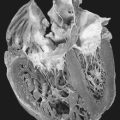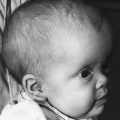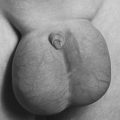90. Zenker’s Diverticulum
Definition
Zenker’s diverticulum is a rare pulsion disorder consisting of an esophageal mucosal herniation posteriorly between the cricopharyngeal muscle and the inferior pharyngeal constrictor muscle (at the junction of the pharynx and esophagus). It is actually a false diverticulum. Zenker’s diverticulum is also called pharyngoesophageal diverticulum.
Incidence
The frequency of occurrence of Zenker’s diverticulum in the United States and Europe is estimated to range from 0.01% to 0.11% of the population. The disorder is rare in the Middle East and Asia. Women are affected more frequently than men. The disorder is more often seen in the elderly, with age of onset typically occurring between 60 to 80 years.
Etiology
Zenker’s diverticulum does not occur in any animal other than humans, so the etiology is poorly understood. Theoretically, the patient with Zenker’s diverticulum has relaxation of the cricopharyngeal muscle that is poorly or improperly synchronized with the act of swallowing. The resultant increased pressure is cumulative, over time producing the posterior herniation of the esophageal mucosa between the inferior pharyngeal constrictor muscle and the cricopharyngeal muscle.
Signs and Symptoms
• Achalasia
• Aspiration pneumonia
• Esophageal spasm
• Esophagogastroduodenal ulceration
• Halitosis
• Hiatal hernia
• Mild-to-moderate weight loss
• Noisy deglutition
• Undigested food regurgitation
• Upper esophageal dysphagia
• Vocal changes
Medical Management
Management of Zenker’s diverticulum consists entirely of surgical intervention. There are no absolute contraindications to surgical repair of Zenker’s diverticulum. However, relative contraindications include (1) small diverticulum (<1 cm in diameter), which may be asymptomatic and may be followed by the surgeon pending development of symptoms and (2) the patient’s ability to withstand the surgical procedure. The patient with strongly symptomatic disease is rarely denied surgical correction because there are many surgical approaches currently possible as well as the adaptability of anesthesia care for the chosen surgical approach.
Complications
• Aspiration
• Pneumonia
• Squamous cell carcinoma
Anesthesia Implications
Because of the nature of Zenker’s diverticulum, surgery is the only definitive management. The anesthetist may need to exercise great flexibility and creativity in providing anesthesia. The anesthetist may be required to “share” the space with the surgical team. For example, when the surgical approach entails a rigid laryngoscopy by an otolaryngologist, the diverticulum may be stapled then excised. To facilitate such an approach, the anesthetist may need to place a smaller-than-usual endotracheal tube. Good muscle relaxation is an essential component of this surgical approach. The anesthetist may thus find it helpful to use an infusion of mivacurium because it can be rapidly discontinued, pharmacologically reversed, and has much less potential for residual effects. The anesthetist must consider the age of the patient with Zenker’s diverticulum (the patient is usually quite elderly) and tailor the anesthetic plan accordingly.
Another surgical approach uses a relatively small incision in one side of the neck, dissects the structures and separates the esophagus from the surrounding musculature, then proceeds to the actual diverticulectomy. The considerations delineated above apply equally to this surgical approach, except the usual size endotracheal tube may be used without interference with the surgery.
Because of the nature of Zenker’s diverticulum, the patient may be required to cease oral intake of liquids and solids for a longer time than usual for general anesthesia. This increased period without oral intake allows more time for the diverticulum to empty before surgery and anesthesia, thus reducing the potential for regurgitation and/or aspiration.
General anesthesia should be induced employing rapid sequence precautions despite the prolonged NPO status. However, the rapid sequence precautions should be modified to exclude cricoid pressure. Frequently, Zenker’s diverticulum is located above the cricoid cartilage. As a result, application of cricoid pressure during the induction may expel any diverticulum contents. It may be more prudent to attempt to empty the diverticulum preoperatively, particularly if the pouch is large, regardless of the length of time the patient has been NPO. H 2 blockers, 5HT-3 antagonists, and/or antacids generally do not affect Zenker’s diverticulum because its location is so distant from the stomach. Placement of a nasogastric or orogastric tube should be withheld because of the risk to the esophagus. Anesthesia should be maintained using short-acting agents to allow for a more rapid emergence at the conclusion of the procedure so that the patient quickly regains control of his or her airway reflexes. The anesthetist must also expect some delay in both induction and emergence as a result of the advanced age typical of patients with Zenker’s diverticulum. Once sugery is completed and the patient has emerged from anesthesia, the oropharynx should be thoroughly suctioned to prevent aspiration of any expelled diverticulum contents at the time of extubation. Transfer to the post-anesthesia care unit should be accomplished with the head of the bed or stretcher elevated at least 30 degrees to reduce the potential for aspiration. In the post-anesthesia care unit, sedation should be kept to a minimum, also to reduce the possibility of aspiration. For more information on anesthesia implications, see Achalasia (p. 1).







